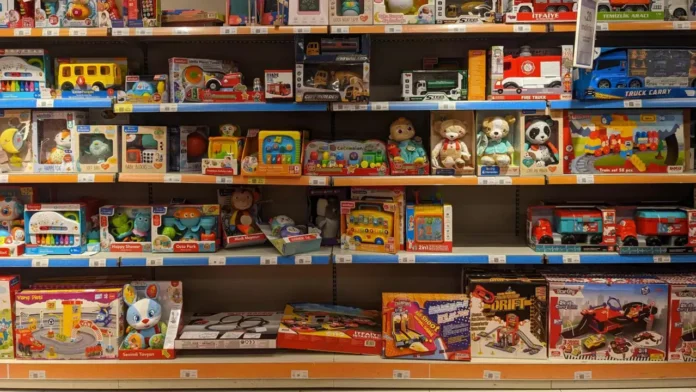India’s toy exports dipped marginally to USD 152.34 million in 2023-24 from USD 153.89 million in the previous financial year, as reported by the economic think tank GTRI. Despite the implementation of mandatory quality control orders, India’s toy exports failed to experience substantial growth, according to the Global Trade Research Initiative (GTRI).
While the domestic measures primarily targeted bolstering the local industry and ensuring safety, they did not notably bolster India’s toy exports, according to the report.
The report indicated a modest increase in exports from USD 129.6 million to USD 177 million from FY’2020 to FY’2022. However, by FY’2024, exports declined to USD 152.3 million.
However, imports surged to USD 64.92 million in 2023-24 from USD 62.37 million in 2022-23.
Continue Exploring: Ace Turtle inaugurates third Toys“R”Us store in India, plans 12 new stores in 2024
Ajay Srivastava, the founder of GTRI, remarked that while the Quality Control Orders (QCO) effectively curbed substandard imports from China, they did not translate into increased exports from India.
“India has undertaken significant measures since 2020 to restrict the influx of substandard toy imports, especially from China, and to bolster the domestic toy industry,” he said. “However, India needs to adopt a broader approach for the development of the sector.”
The report suggests a holistic strategy aimed at fostering the growth of India’s toy industry and increasing exports.
He recommended initiatives such as cultivating a strong domestic ecosystem, enticing global toy brands to establish manufacturing operations in India, drawing lessons from China, and localizing the production of essential inputs.
Srivastava emphasized the importance of investing in research and development to stimulate innovation in toy design and functionality, thus positioning Indian toys competitively worldwide. He also highlighted the need to enhance collaborations between toy manufacturers and design institutes to consistently introduce innovative products.
The report suggested the establishment of specialized toy manufacturing hubs to cut costs and improve efficiency, alongside modernizing traditional Indian toys while preserving their cultural significance to craft distinctive products.
It proposed supporting small and medium enterprises in utilizing digital marketing and advocating for Indian toys at international fairs to establish global connections.
Additionally, it suggested that India extend invitations to international toy manufacturers, including companies like Hasbro, Mattel, Lego, Spin Master, and MGA Entertainment, currently operating in China, to explore the possibility of establishing production facilities in India.
This initiative could potentially redirect a portion of the global toy production market to India.
Moreover, it suggested decreasing reliance on imports by enhancing local production capacities for essential toy-making materials and components, including glass eyes for dolls, beads, imitation stones, various plastics, electric motors, and remote control devices.
According to GTRI, this measure will lower costs and bolster the self-reliance of the Indian toy sector.
Continue Exploring: Walmart targets $10 Billion annual exports from India, with toys taking center stage
Srivastava pointed out that imports of inputs used in toy manufacturing surpass imports of finished toys. “For instance, in FY’2024, we imported glass eyes for dolls or other toys, beads, and imitation stones worth USD 137.2 million.”
He emphasized the necessity for India to devise distinct strategies for various categories of toys, such as plush toys like stuffed animals (with a global trade value of about USD 7 billion); educational toys (with a global trade value of about USD 6 billion); construction toys like LEGO (USD 10 billion); action figures and dolls (USD 10 billion); electronics (USD 15 billion); board games and puzzles (USD 9 billion); and outdoor and sports toys (USD 5 billion).
In 2022, the global market imported toys valued at about USD 60.3 billion.
Leading this market, China exported toys valued at USD 48.3 billion, capturing an 80 percent share of global exports.
Other notable contributors to the global toy export market comprise the Czech Republic with exports totaling USD 3.2 billion, the European Union with USD 2.7 billion, Vietnam with USD 1.7 billion, and Hong Kong with USD 1.1 billion.
On the flip side, India’s contribution to the worldwide toy export sector is meager, amounting to just USD 167 million. This figure accounts for merely 0.3 percent of global exports, positioning it at the 27th spot, as per the report.
Continue Exploring: Toys ‘R’ Us bets big on Indian market, eyes top five position within 4-5 years
In terms of imports, India falls even further behind, securing the 61st position, with toy imports totaling USD 60 million.
The United States emerges as the top importer of toys, single-handedly acquiring toys valued at USD 22.2 billion. It is trailed by the European Union at USD 9 billion, Japan at USD 2.8 billion, and Canada at USD 1.6 billion.
India hiked import duties on toys starting from February 2020. The basic customs duty saw a surge from 20 percent to 60 percent, further escalating to 70 percent by July 2021.
Enforced since January 2021, the QCO (Quality Control Order) stipulates that all toys distributed in India, regardless of their origin—domestically manufactured or imported—must adhere to designated Indian safety standards.





